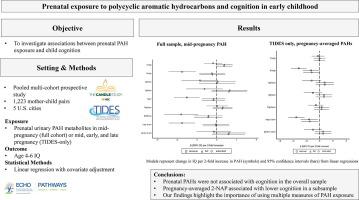当前位置:
X-MOL 学术
›
Environ. Int.
›
论文详情
Our official English website, www.x-mol.net, welcomes your
feedback! (Note: you will need to create a separate account there.)
Prenatal exposure to polycyclic aromatic hydrocarbons and cognition in early childhood
Environment International ( IF 10.3 ) Pub Date : 2023-06-02 , DOI: 10.1016/j.envint.2023.108009 Bob Sun 1 , Erin R Wallace 2 , Yu Ni 2 , Christine T Loftus 2 , Adam Szpiro 3 , Drew Day 4 , Emily S Barrett 5 , Ruby H N Nguyen 6 , Kurunthachalam Kannan 7 , Morgan Robinson 7 , Nicole R Bush 8 , Sheela Sathyanarayana 9 , Alex Mason 10 , Shanna H Swan 11 , Leonardo Trasande 7 , Catherine J Karr 12 , Kaja Z LeWinn 13
Environment International ( IF 10.3 ) Pub Date : 2023-06-02 , DOI: 10.1016/j.envint.2023.108009 Bob Sun 1 , Erin R Wallace 2 , Yu Ni 2 , Christine T Loftus 2 , Adam Szpiro 3 , Drew Day 4 , Emily S Barrett 5 , Ruby H N Nguyen 6 , Kurunthachalam Kannan 7 , Morgan Robinson 7 , Nicole R Bush 8 , Sheela Sathyanarayana 9 , Alex Mason 10 , Shanna H Swan 11 , Leonardo Trasande 7 , Catherine J Karr 12 , Kaja Z LeWinn 13
Affiliation

|
Epidemiological evidence for gestational polycyclic aromatic hydrocarbon (PAH) exposure and adverse child cognitive outcomes is mixed; little is known about critical windows of exposure. We investigated associations between prenatal PAH exposure and child cognition in a large, multi-site study. We included mother–child dyads from two pooled prospective pregnancy cohorts (CANDLE and TIDES, N = 1,223) in the ECHO-PATHWAYS Consortium. Seven urinary mono-hydroxylated PAH metabolites were measured in mid-pregnancy in both cohorts as well as early and late pregnancy in TIDES. Child intelligence quotient (IQ) was assessed between ages 4–6. Associations between individual PAH metabolites and IQ were estimated with multivariable linear regression. Interaction terms were used to examine effect modification by child sex and maternal obesity. We explored associations of PAH metabolite mixtures with IQ using weighted quantile sum regression. In TIDES, we averaged PAH metabolites over three periods of pregnancy and by pregnancy period to investigate associations between PAH metabolites and IQ. In the combined sample, PAH metabolites were not associated with IQ after full adjustment, nor did we observe associations with PAH mixtures. Tests of effect modification were null except for the association between 2-hydroxynaphthalene and IQ, which was negative in males (β = −0.67 [95%CI:−1.47,0.13]) and positive in females (β = 0.31 [95%CI:−0.52,1.13])( = 0.04). In analyses across pregnancy (TIDES-only), inverse associations with IQ were observed for 2-hydroxyphenanthrene averaged across pregnancy (β = −1.28 [95%CI:−2.53,−0.03]) and in early pregnancy (β = −1.14 [95%CI:−2.00,−0.28]). In this multi-cohort analysis, we observed limited evidence of adverse associations of early pregnancy PAHs with child IQ. Analyses in the pooled cohorts were null. However, results also indicated that utilizing more than one exposure measures across pregnancy could improve the ability to detect associations by identifying sensitive windows and improving the reliability of exposure measurement. More research with multiple timepoints of PAH assessment is warranted.
中文翻译:

产前接触多环芳烃与幼儿期认知
关于妊娠期多环芳烃 (PAH) 暴露和不良儿童认知结果的流行病学证据是混杂的;对于关键的暴露窗口知之甚少。我们在一项大型多中心研究中调查了产前多环芳烃暴露与儿童认知之间的关联。我们将来自 ECHO-PATHWAYS 联盟的两个合并的前瞻性妊娠队列(CANDLE 和 TIDES,N = 1,223)的母婴二元组纳入其中。在两个队列的妊娠中期以及 TIDES 的妊娠早期和晚期测量了 7 种尿液单羟基化 PAH 代谢物。儿童智商 (IQ) 在 4-6 岁之间进行评估。个体多环芳烃代谢物与智商之间的关联通过多元线性回归进行估计。使用交互项来检查儿童性别和母亲肥胖的影响修改。我们使用加权分位数和回归探讨了多环芳烃代谢物混合物与智商的关联。在 TIDES 中,我们对三个妊娠期和妊娠期的 PAH 代谢物进行了平均,以研究 PAH 代谢物与智商之间的关联。在合并样本中,经过全面调整后,PAH 代谢物与 IQ 无关,我们也没有观察到与 PAH 混合物的关联。除了 2-羟基萘与 IQ 之间的关联外,效果修正检验无效,该关联在男性中呈阴性 (β = -0.67 [95%CI:−1.47,0.13]),在女性中呈阳性 (β = 0.31 [95%CI:−1.47,0.13]) :−0.52,1.13])(=0.04)。在整个怀孕期间的分析中(仅限潮汐),观察到整个怀孕期间(β = -1.28 [95%CI: -2.53, -0.03])和早孕期间(β = -1.14 [ 95%CI:−2.00,−0.28])。在这项多队列分析中,我们观察到早期妊娠多环芳烃与儿童智商不利相关的证据有限。合并队列中的分析无效。然而,结果还表明,在整个怀孕期间使用多种暴露测量可以通过识别敏感窗口和提高暴露测量的可靠性来提高检测关联的能力。有必要进行更多多时间点 PAH 评估的研究。
更新日期:2023-06-02
中文翻译:

产前接触多环芳烃与幼儿期认知
关于妊娠期多环芳烃 (PAH) 暴露和不良儿童认知结果的流行病学证据是混杂的;对于关键的暴露窗口知之甚少。我们在一项大型多中心研究中调查了产前多环芳烃暴露与儿童认知之间的关联。我们将来自 ECHO-PATHWAYS 联盟的两个合并的前瞻性妊娠队列(CANDLE 和 TIDES,N = 1,223)的母婴二元组纳入其中。在两个队列的妊娠中期以及 TIDES 的妊娠早期和晚期测量了 7 种尿液单羟基化 PAH 代谢物。儿童智商 (IQ) 在 4-6 岁之间进行评估。个体多环芳烃代谢物与智商之间的关联通过多元线性回归进行估计。使用交互项来检查儿童性别和母亲肥胖的影响修改。我们使用加权分位数和回归探讨了多环芳烃代谢物混合物与智商的关联。在 TIDES 中,我们对三个妊娠期和妊娠期的 PAH 代谢物进行了平均,以研究 PAH 代谢物与智商之间的关联。在合并样本中,经过全面调整后,PAH 代谢物与 IQ 无关,我们也没有观察到与 PAH 混合物的关联。除了 2-羟基萘与 IQ 之间的关联外,效果修正检验无效,该关联在男性中呈阴性 (β = -0.67 [95%CI:−1.47,0.13]),在女性中呈阳性 (β = 0.31 [95%CI:−1.47,0.13]) :−0.52,1.13])(=0.04)。在整个怀孕期间的分析中(仅限潮汐),观察到整个怀孕期间(β = -1.28 [95%CI: -2.53, -0.03])和早孕期间(β = -1.14 [ 95%CI:−2.00,−0.28])。在这项多队列分析中,我们观察到早期妊娠多环芳烃与儿童智商不利相关的证据有限。合并队列中的分析无效。然而,结果还表明,在整个怀孕期间使用多种暴露测量可以通过识别敏感窗口和提高暴露测量的可靠性来提高检测关联的能力。有必要进行更多多时间点 PAH 评估的研究。











































 京公网安备 11010802027423号
京公网安备 11010802027423号